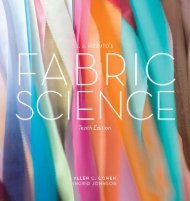Visual Merchandising Display - Fairchild Books
Visual Merchandising Display - Fairchild Books
Visual Merchandising Display - Fairchild Books
Create successful ePaper yourself
Turn your PDF publications into a flip-book with our unique Google optimized e-Paper software.
The Color of Light<br />
Color—as color—means little unless it is considered in<br />
relation to the type of light in which the color is seen. It is<br />
light that makes things visible. All colors depend on light.<br />
There is natural daylight and artificial light, which can<br />
be incandescent, fluorescent, or high-intensity discharge<br />
(HID) lighting.<br />
It is not quite that simple, however. These three broad<br />
classifications of artificial light are further subdivided. There<br />
are many different types of fluorescent lamp tubes available,<br />
ranging from a warm white deluxe that attempts to create<br />
an “incandescent” effect, to the cool, bluish “daylight”<br />
quality usually associated with fluorescent lighting. HID<br />
lamps are being improved daily and now even approach the<br />
warm end of the colored light scale. Incandescent lamps<br />
(i.e., bulbs) are warm and glowing, but placing filters or gel<br />
sleeves over them can change the color and quality of the<br />
light. Let us, therefore, consider the color of light, the effect<br />
of light on pigment color, and how light can affect the merchandise<br />
and the area that surrounds the merchandise.<br />
Visible light is actually composed of the whole spectrum<br />
of colors, from violet to red. Imagine a beam of light passing<br />
through a glass prism or reflecting in a pool of water or oil,<br />
and you will see that spectrum broken up into a rainbow of<br />
colors—from violet, through the blues and greens, to the<br />
yellows and oranges, and finally, red. All light is caused by<br />
waves of radiant energy that vary in length. The shortest<br />
wavelength of the visible spectrum is violet light; then comes<br />
blue light, green light, and so on; and at the other end of the<br />
spectrum, with the longest wavelength, is red light. All these<br />
wavelengths—the entire spectrum—combine to form visible,<br />
or white, light, which is the light we see.<br />
Ultraviolet light, X-rays, and gamma rays have shorter<br />
wavelengths than we can see. Infrared and radio waves<br />
are too long for us to perceive. For the purpose of understanding<br />
light and color in display and store planning,<br />
this discussion will be limited to the colors that appear in<br />
the visible spectrum. We will find that some light sources<br />
reflect the shorter wavelengths and emit cooler, or bluer,<br />
light, whereas others have a warmer light and favor the<br />
longer wavelengths.<br />
32<br />
P a r t 1 : G e t t i n G S ta r t e d — V i S u a l M e r c h a n d i S i n G a n d d i S P l ay B a S i c S<br />
To comprehend the relationship between color and<br />
light and why an object is perceived by an observer as a<br />
particular color, it is important to understand that light is<br />
capable of being reflected and absorbed. The color of an<br />
object is seen as a result of the object’s selective absorption<br />
of light rays. Thus, if an object is blue, for example, this<br />
means that it absorbs all the wavelengths of light except<br />
those of blue light, which are reflected back to the observer.<br />
The same occurs with other colors, but with a different<br />
wavelength being reflected.<br />
If the object is pure white, the full visible spectrum of<br />
light is being reflected back in approximately equal quantities.<br />
If it is pure black, then all colors in the spectrum are<br />
being absorbed by the object.<br />
Light bounces from one surface to another, and in<br />
this movement it is capable of throwing off new colors.<br />
For example, a wall or panel is painted pink. A wedgewood-blue<br />
carpet is installed. If warm, incandescent<br />
lights are used, the carpet may turn slightly lavender from<br />
the warm pink reflection cast by the walls. The incandescent<br />
light may also play up any reds that are in the warm<br />
blue carpet. (A warm blue has some purple in it, i.e.,<br />
red and blue. Incandescent light reflects most in the red<br />
end of the spectrum.) If a daylight fluorescent light were<br />
switched on instead, the blue of the carpet might seem<br />
more sparkling and cool, and the walls would take on<br />
the lavender tone. The overall light will affect the color<br />
of the walls, the floor, and the ceiling, and bouncing<br />
around as it does, most of all it will affect the color of the<br />
merchandise.<br />
Planning Window Lighting<br />
You walk by a store. It is daylight. You catch a glimpse of the<br />
window, and all you see is yourself reflected in the window<br />
of a store that may or may not be open for business. In that<br />
glimpse you can check out what you are wearing, but you<br />
haven’t a single clue as to what lies beyond the glass. What<br />
kind of store is it? What sort of merchandise is sold there?<br />
When a store’s windows are not illuminated, or are illuminated<br />
improperly, they become a giant one-way mirror<br />
facing the street or the mall.













